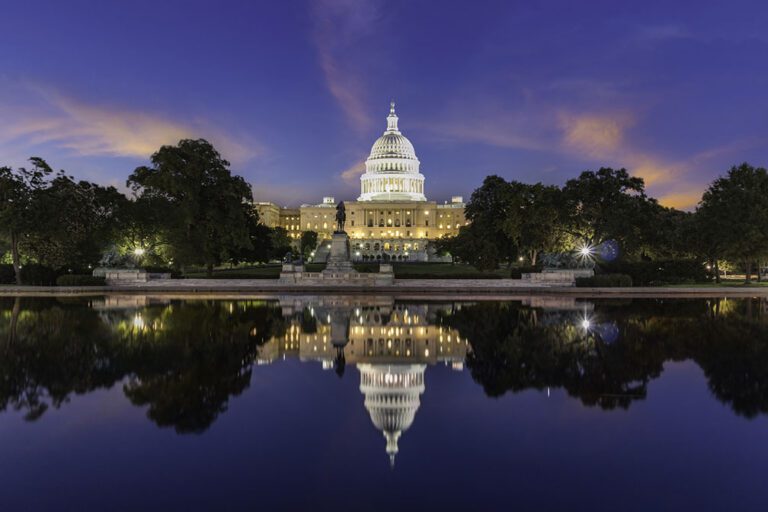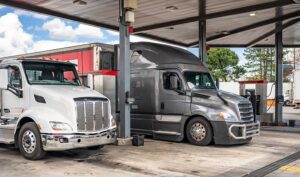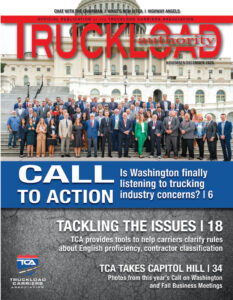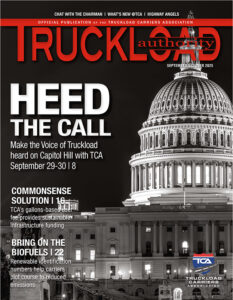The federal government has doled out more than $471 million in grants to help reduce commercial vehicle accidents. Meanwhile, the Commercial Vehicle Safety Alliance announces the results of Brake Safety Day as well as results from the 2023 Human Trafficking Awareness Initiative. The Federal Motor Carrier Safety Administration is also working to combat trafficking with the launch of a new human trafficking awareness program aimed at truckers. And, in Washington state, the government is making it easier for truckers to access restrooms. Find out about these issues, along with other news affecting the trucking industry, below.
Big rigs play key role in plans as emissions focus turns to ocean freight
If plans succeed, the Pacific corridor between Los Angeles and Shanghai will become a showcase for slashing carbon emissions from the shipping industry.
The International Maritime Organization (IMO), which regulates commercial shipping, wants to halve its greenhouse gas releases by midcentury and may seek deeper cuts this year.
“Shipping must embrace decarbonization,” said IMO Secretary-General Kitack Lim in February.
Meeting agency targets will require significant vessel and infrastructure changes. That’s inspiring plans for “green shipping corridors” along major routes where new technologies and methods could be fast-tracked and scaled up.
More than 20 partnerships for these corridors have been proposed. They’re largely on paper now but are expected to take shape in the coming years. The goal is to unite marine fuel producers, vessel owners and operators, cargo owners, and ports in a common effort to reduce emissions.
Los Angeles and Shanghai formed a partnership last year.
“The vision is that a container will leave a factory on a zero-emissions truck (in China),” said Gene Seroka, executive director of the Port of Los Angeles. “It will arrive at the port of Shanghai, be loaded onto a ship by a zero-emissions cargo handling equipment unit and move across the Pacific Ocean on a vessel that emits zero carbon. Once it gets to Los Angeles, the reverse happens,” with carbon-free handling and distribution.
Los Angeles entered a second agreement in April with Long Beach and Singapore. Others in the works include the Great Lakes-St. Lawrence River; a Chilean network; and numerous corridors in Asia, North America and Europe.
New approaches developed in green corridors could bring fast results, said John Bradshaw, technical director for environment and safety with the World Shipping Council. “I’m very confident that the industry will deliver zero emissions by 2050.”
Roughly 90% of traded goods move on water, some in behemoths longer than four football fields, each holding thousands of containers with consumer products. About 58,000 commercial ships ply the seas. Their emissions are less noticeable than onshore haulers such as trucks, although noxious fumes from ships draw complaints in port communities.
Maritime trade volumes are expected to triple by 2050, according to the Organization for Economic Cooperation and Development. Studies predict the industry’s share of greenhouse gas emissions could reach 15%.
Yet the 2015 Paris climate accord exempts maritime shipping, partly because vessels do business worldwide, while the agreement covers nation-by-nation goals.
“No one wants to take responsibility,” said Allyson Browne of Pacific Environment, an advocacy group. “A ship may be flagged in China, but who takes ownership of emissions from that ship when it’s transporting goods to the U.S.?”
The IMO responded to mounting pressure with a 2018 plan for a 50% emissions reduction by midcentury from 2008 levels. An update scheduled for July may set more ambitious targets favored by the U.S., Europe and small island nations. Opponents include Brazil, China, and India.
The Biden administration wants a zero-emission goal, but less than half of large shipping companies have pledged to meet international carbon objectives. And there’s no consensus about how to accomplish them. Proposals range from slowing vessels down to charging them for emissions, as the European Union did last year.
“Global shipping is hard to decarbonize … because of the energy required to cover long distances with heavy cargoes,” said Lee Kindberg, head of environment and sustainability for Maersk North America, part of A.P. Moller-Maersk, which has more than 700 vessels. “It’s a stretch but we consider it doable.”
Mechanical sails, batteries, and low- or zero-carbon liquid fuels are among propulsion methods touted as replacements for “bunker fuel” that powers most commercial ships — thick residue from oil refining. It spews greenhouse gases and pollutants that endanger human health: sulfur dioxide, nitrogen oxide, and soot. Finding alternatives will be a priority for green shipping corridors.
For now, liquid natural gas is the runaway choice. Worldwide, it’s used by 923 of 1,349 commercial vessels not powered by conventional fuels, according to a study last year by DNV, a Norway-based maritime accreditation society. Many environmentalists oppose LNG because it emits methane, another potent greenhouse gas. Defenders say it’s the quickest and most cost-effective bunker fuel substitute.
Before building or buying low-emission vessels, companies want assurances clean fuels will be available and affordable. Companies producing the fuels, meanwhile, want enough ships using them to guarantee strong markets.
And both need port infrastructure that accommodates new-generation ships, including electrical hookups and clean fuel dispensing mechanisms.
But ports await demand to justify such expensive upgrades. Switching onshore cargo handling equipment and trucks to zero-emission models will cost the Los Angeles port $20 billion, officials say.
“Once you put a (green) corridor on the map,” said Jason Anderson, senior program director for the nonprofit ClimateWorks Foundation, “at least they’re heading in the same direction.”
Success will require government regulation and corridor funding, along with support from shipping industry customers, said Jing Sun, a University of Michigan marine engineering professor.
“Shipping is the most cost-effective way of moving things around,” Sun said.
An organization called Cargo Owners for Zero Emission Vessels pledges to use only zero-emission shipping companies by 2040. Among 19 signatories are Amazon, Michelin and Target.
“When big corporate buyers come together and say we need this to happen, the rest of the chain has the confidence to make needed investments,” said Ingrid Irigoyen, an assistant director of the nonprofit Aspen Institute, which helped assemble the group.
CVSA removes more than 750 commercial trucks from service during brake inspection blitz
The Commercial Vehicle Safety Alliance (CVSA) conducted an unannounced Brake Safety Day on April 19, 2023. During the surprise inspection blitz, a total of 6,829 commercial motor vehicles (CMVs) were inspected throughout Canada, Mexico and the U.S.
According to the CVSA, inspectors found brake-related critical vehicle inspection items on 11.3% of the vehicles inspected, indicating those vehicles were unfit and unsafe for roadways. As a result, inspectors restricted those 773 CMVs from travel until the violations were corrected.
During this one-day unannounced inspection and enforcement campaign, certified CMV inspectors conducted their usual vehicle and driver inspections. In addition, they reported brake-related data to CVSA to provide a one-day snapshot of the state of brake systems on the CMVs that travel North American roadways every day.
The top three brake-related out-of-service conditions were:
- Brakes Violations (of 20% or more) – 479
A vehicle or combination of vehicles is declared out of service when 20% or more of its service brakes have an out-of-service condition resulting in a defective brake, such as a brake out of adjustment, an audible air leak at the chamber, defective linings/pads, a missing brake where brakes are required, etc.
- Other Brake Violations – 368
Examples of other out-of-service brake violations include worn brake lines, broken brake drums, inoperative tractor protection system, inoperative low air warning devices, air leaks, hydraulic fluid leaks, etc.
- Steering Brake Violations – 81
Examples of automatic standalone out-of-service steering axle brake violations are inoperative brakes, mismatched brake chambers, mismatched slack adjuster length, defective linings, etc.
CVSA’s membership consists of jurisdictions in Canada, Mexico and the U.S. All three countries participated in this year’s unannounced Brake Safety Day, for a total of 56 jurisdictions.
In Canada, 10% (88 vehicles) of the 894 total CMVs inspected were placed out of service for brake-related violations. In Mexico, only 34 CMVs were inspected; six of them (18%) were found to have brake-related out-of-service violations and were placed out of service. In the U.S., inspectors placed 679 (11.5%) of the 5,901 total CMVs inspected out of service for brake-related violations.
CVSA officials noted that Brake Safety Day is also an opportunity to obtain additional data related to the health and wellness of brake systems on CMVs. This year, the CVSA focused on capturing data on brake lining/pad violations. Brake lining/pad conditions can result in violations and affect a motor carrier’s safety rating.
Of the 6,829 CMVs inspected, 108 power unit and 87 towed unit lining/pad violations were identified, for a total of 195 combined lining/pad violations.
In addition, eight of the CVSA member jurisdictions with performance-based brake testers (PBBTs) used those machines on Brake Safety Day to assess the braking performance of CMVs. Those participating jurisdictions conducted 92 inspections with PBBTs. There were four failures (4.35%), which meant those four CMVs were placed out of service for overall vehicle braking efficiency.
CVSA releases 2023 Human Trafficking Awareness Initiative results
All three of the Commercial Vehicle Safety Alliance’s (CVSA) member countries — Canada, Mexico, and the U.S. — participated in this year’s Human Trafficking Awareness Initiative (HTAI), a five-day awareness and outreach campaign to educate commercial motor vehicle drivers, motor carriers, law enforcement officers, and the general public about human trafficking.
Forty-five jurisdictions took part in this year’s Human Trafficking Awareness Initiative, with participation from 3,020 individual law enforcement officers, troopers, and inspectors. There were 218 human trafficking awareness and preventions events, and 219 presentations were delivered. In addition, there were 8,352 media contacts throughout North America.
CVSA collaborated with Truckers Against Trafficking to offer human trafficking identification and prevention training and reference materials to the motor carrier industry and law enforcement. During the five days of HTAI, 45,972 wallet cards and 21,763 window decals were distributed.
After the successful launch of CVSA’s HTAI in 2022 and positive feedback from jurisdictions, CVSA extended the initiative from three days to five for 2023. Different dates were set for each country to align existing human trafficking awareness days with CVSA’s five-day Human Trafficking Awareness Initiative. In the U.S., the initiative took place Jan. 9-13. In Canada, it was Feb. 20-24. And in Mexico, it was March 13-17.
If you suspect someone is in a human trafficking situation or you are the victim of human trafficking:
In the U.S., call (888) 373-7888. In Canada, call (833) 900-1010. In Mexico, call (800) 5533-000.
To find out what your local jurisdiction is doing to increase human trafficking awareness and prevent human trafficking throughout the year, contact the agency/department responsible for overseeing commercial motor vehicle safety within your state, province or territory.
FMCSA launches new human trafficking awareness program aimed at truckers
The U.S. Department of Transportation’s Federal Motor Carrier Safety Administration (FMCSA) recently launched its new human trafficking awareness campaign — “Your Roads, Their Freedom.”
The campaign seeks to give the nation’s 8.7 million commercial motor vehicle (CMV) drivers the information needed to identify and report suspected human trafficking.
“Human trafficking is a heinous crime, and it has no place in the transportation industry,” said FMCSA Administrator Robin Hutcheson. “But the hard-hitting reality is that our nation’s transportation systems are exploited by human traffickers every day, and FMCSA is working to help stop it.”
Globally, an estimated 28 million people are currently subjected to human trafficking, and the crime occurs in every state of the U.S. As part of DOT’s Transportation Leaders Against Human Trafficking (TLAHT) awareness campaign, the “Your Roads, Their Freedom” campaign will build on other federal efforts against human trafficking, including the Department of Homeland Security’s Blue Campaign and FMCSA’s grant programs, which awarded millions in funding to support state counter-trafficking efforts.
Through the “Your Roads, Their Freedom” campaign and other federal agency efforts, DOT aims “to empower America’s transportation workforce, which is millions strong, to be the eyes and ears of our collective effort,” as highlighted by U.S. Transportation Secretary Buttigieg in his remarks made to the President’s Interagency Task Force on Human Trafficking in February of this year.
Truckers made over 1,400 calls to the U.S. National Human Trafficking Hotline from December 2007 through June 2016, and 452 potential human trafficking cases were identified. Truckers reported this information in real-time, enabling quicker responses by law enforcement.
While the “Your Roads, Their Freedom” campaign will be conducted nationwide, there will be a heightened emphasis across states with the highest reported number of human trafficking cases or a high volume of driver traffic. These states include California, Florida, Michigan, New York, and North Carolina among others.
Feds dole out more than $471M in grants to help reduce commercial vehicle wrecks
Washington Gov. Jay Inslee has signed a new law that requires shippers to provide restroom access to truck drivers during normal business hours. House Bill 1457 goes into effect on July 23.
According to the law, restrooms must be located in an area “where providing access would not create an obvious health or safety risk to the motor carrier.”
Additionally, there must not be any obvious security, health or safety risk to the shipper, consignee or its employees.
A shipper or consignee is not required to make any physical changes to a restroom and may require that an employee accompany a motor carrier to the restroom, the law states.
Under the law, a consignee is described as a person or business who takes delivery of property, cargo or materials transported in interstate or intrastate commerce from a motor carrier.
Failing to comply with the new law will result in the Department of Health issuing a warning letter for a first violation. A shipper or consignee that violates the law after receiving a warning letter will be found guilty of a class 2 civil infraction.
The maximum penalty for a Class 2 civil infraction is $300, not including statutory assessments, according to the state of Washington.
Latest round of Bipartisan Infrastructure Law allocations offer benefits to trucking
In May, the White House released a breakdown on allocations for the Bipartisan Infrastructure Law (BIL) spending. So far, more than $220 billion in funds have been made available for more than 32,000 specific projects across more than 4,500 communities in all 50 states, the District of Columbia, and U.S. territories, according to a statement from the White House.
Projects include money for truck parking and major infrastructure improvements that will be of direct benefit to the trucking industry. The following are only a few projects noted on the White House list.
Brent Spence Bridge
The Department of Transportation (DOT) awarded $250 million for the Brent Spence Bridge, which connects Kentucky and Ohio through the Mega Grant Program, part of a total investment of $1.6 billion from the infrastructure law to build a new companion bridge and rehabilitate an existing bridge along a major freight corridor on Interstate 75.
Economic officials say the bridge is a vital economic connection that carries a large amount of commuter traffic and more than $400 billion in freight movement annually. This project will contribute to mobility, freight movement and supply chains nationwide.
Otay Mesa Port of Entry Expansion
The California Department of Transportation has been awarded $150 million to construct a new road and port of entry facility at Otay Mesa, according to transportation officials. The new port of entry will provide an alternative for nearly 3,600 trucks that cross the existing Otay Mesa and Tecate ports of entries daily; both facilities are now operating at full capacity.
The project facilitates freight movement across borders with destinations at nearby distribution centers and warehouses, the Ports of Los Angeles and Long Beach, and the Inland Empire’s mega-distribution centers in Riverside and San Bernardino counties.
I-4 West Central Florida Truck Parking Facility
A $15 million grant will help build a new truck parking facility with about 120 spaces, electric charging stations, and pedestrian infrastructure to access nearby amenities. This corridor, which links Tampa and Orlando, carries an average of 18,000 trucks daily but currently lacks sufficient parking.
The facility will be connected to Florida’s Department of Transportation Truck Parking Availability System to help drivers identify available parking locations more quickly. By providing reliable parking capacity, the project improves safety for tired drivers and makes supply chain movement more efficient.
Hunts Point Terminal Redevelopment
New York City has been awarded a $110 million Infrastructure for Rebuilding America (INFRA) grant to support the redevelopment of the Hunts Point Terminal Produce Market intermodal facility with expanded refrigerated warehouse space and electric vehicle charging stations for trucks and cars.
The new Produce Market will be an approximately 1 million-square-foot, state-of-the-art intermodal facility with approximately 824,600 square feet of refrigerated warehouse space. The project will boost the economy by improving one of the largest food distribution centers in the country, according to transportation officials.
In addition, the project is expected to make the operation safer by separating vehicular, truck, rail, and pedestrian circulation and expanding truck queuing and parking areas within the facility. With the new facility, diesel-powered truck refrigeration units will no longer idle on site, resulting in emissions reductions, according to officials.
This article originally appeared in the July/August 2023 edition of Truckload Authority, the official publication of the Truckload Carriers Association.
The Truckload Authority News Staff, comprised of award winning journalists and graphic artists, produces content for Truckload Authority, working in cooperation with the Truckload Carriers Association staff. Truckload Authority aims to keep TCA members abreast on the latest trends in the trucking industry as well as articles that feature TCA member executives and drivers. The Truckload Authority staff is based in Little Rock, Arkansas.














